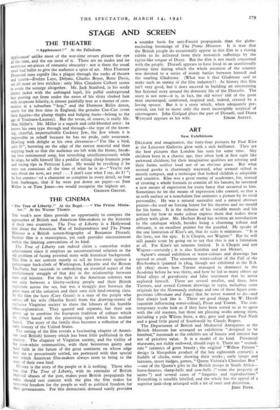ART
New Exhibitions
DELICATE and imaginative, the forty-four pictures by Paul Klee at the Leicester Galleries glow with a rich brilliance. They are the best pictures that London has seen for some time. Shy children born in a chaotic age, they often look at first sight like awkward children; for their imaginative qualities are retiring and their forms neither loud nor of an obvious grace. But what seemed gawky is charmingly wayward, what seemed stilted is merely compact, and a technique that looked childish is adaptable and sensitive. Klee was a great enemy of academies, for, instead of creating a whole formula to contain all his fancies, he invented a new means of expression for every fancy that occurred to him. Sometimes he let the means of expression take control, so that a sn.00th surface or a nonchalant line animates a picture by its vivid personality. He was a natural surrealist and a natural abstract painter—he used no forcing house for his theories and no mould for his forms. It is the richness of his variable moods and his instinct for how to make colour express them that makes these gallery walls glow. Mr. Herbert Read has written an introduction to the catalogue which, besides being a charming tribute and obituary, is an excellent pointer for the puzzled. He speaks of the one limitation of Klee's art, that its scale is miniature. " It is the lyric, not the epic. It is Chopin, not Wagner." But he will still puzzle some by going on to say that this is not a limitation at all. For Klee's art remains limited. It is Chopin and not Wagner—certainly ; it is also Scriabin and not Mozart.
Agnew's annual exhibition of water-colours and drawings has opened as usual. The enormous water-colour of the Fall of the Reichenbach (painted in 1804, though not exhibited in the R.A. till 1815) shows how Turner managed to domineer in the Academy before he was thirty, and how he led so many others up blind alleys of grandiosity and false sentiment that he never explored himself. There are several smaller, and finer, later Turners, and several Cotman drawings in sepia, including some originals for the Normandy etchings and one of those figure com- positions (Abraham and Isaac) that he never wanted to do—and that always look like it. There are good things by W. Havell (aquatint influencing water-colour), Prout and Towne. The con- temporary works look as if they have been sorted so as to agree with the old masters, but there are pleasing works among them, including a pale Wilson Steer, a dry, grey and green Paul Nash and a good little pastel of Southwold by Claude Rogers.
The Department of British and Mediaeval Antiquities at the British Museum has arranged an exhibition " designed to be bombed," inasmuch as the exhibits are of beauty and interest but not of priceless value. It is a model of its kind. Provincial museums, not richly endowed, should copy it. There are " second- rate " ceramics of great beauty ; the original " Willow Pattern " design (a Shropshire product of the late eighteenth century); a huddle of clocks, some showing their works ; early laMps and lanterns, street badges, games, " Queen Victoria's Chocolate Box " —one of the Queen's gifts to the British troops in South Africa- horse-brasses, sheep-bells and cow-bells (" some the property of saints ") and several cases of " forgeries and reproductions." Everything is sensibly labelled, and the whole has the appeal of a superior junk-shop arranged with a lot of taste and discretion.
JoHN PIPER.






























 Previous page
Previous page